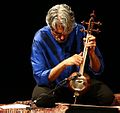Kamancheh

The kamancheh (also kamānche or kamāncha) (Persian: کمانچه, Azerbaijani: kamança, Armenian: քամանչա, Kurdish: کەمانچە ,kemançe) is an Iranian bowed string instrument used in Persian, Azerbaijani, Armenian, Kurdish, Georgian, Turkmen, and Uzbek music with slight variations in the structure of the instrument.
The kamancheh is related to the rebab which is the historical ancestor of the kamancheh and the bowed Byzantine lyra. The strings are played with a variable-tension bow.
In 2017, the art of crafting and playing with Kamantcheh/Kamancha was included into the UNESCO Intangible Cultural Heritage Lists of Azerbaijan and Iran.
Name and etymology
The word "kamancheh" means "little bow" in Persian (kæman, bow, and -cheh, diminutive). The Turkish word kemençe is borrowed from Persian, with the pronunciation adapted to Turkish phonology.
It also denotes a bowed string instrument, but the Turkish version differs significantly in structure and sound from the Persian kamancheh.
There is also an instrument called kabak kemane literally "pumpkin-shaped bow instrument" used in Turkish music which is only slightly different from the Iranian kamancheh.
Structure
The kamancheh has a long neck including the fingerboard, which the kamancheh maker shapes as a truncated inverse cone for easy bow movement in the down section, pegbox in both sides of which four pegs are placed, and finial Traditionally kamanchehs had three silk strings, but modern instruments have four metal strings.
Kamanchehs may have highly ornate inlays and elaborately carved ivory tuning pegs.
The body has a long upper neck and a lower bowl-shaped resonating chamber made from a gourd or wood, usually covered with a membrane made from the skin of a lamb, goat or sometimes a fish, on which the bridge is set.
From the bottom protrudes a spike to support the kamancheh while it is being played, hence in English, the instrument is sometimes called the spiked fiddle.
It is played sitting down held like a cello though it is about the length of a viol. The end-pin can rest on the knee or thigh while the player is seated in a chair.
Kamancheh is usually tuned like an ordinary violin (G, D, A, E).
- Kamancha in an Armenian miniature, XVI or XVII century.
- Qajar Iran miniature of a woman playing the kamancheh.
- A woman playing the kamancheh. Detail from a wall painting in which Mohammad Ali Shah Qajar is surrounded by musicians and dancers. Painted by Abuʾl-Qasim, dated 1816.
- Woman playing kamancheh, ca. 1820.
- The Armenian ashugh Sayat-Nova playing a kamanacheh, ca. 1964.
- Azerbaijani kamancheh player Malik Mansurov.
- Kamancheh player, Kermanshah, Iran, 2008.
- Kamancha player, Yerevan.
Notable kamancheh players
- Habil Aliyev
- Mehdi Bagheri
- Ali-Asghar Bahari
- Mark Eliyahu
- Kayhan Kalhor
- Ardeshir Kamkar
- Kourosh Babaei
- Sayat-Nova
- Mostafa Taleb
- Yaara Beeri
- Mehrnam Rastegari
See also
- List of bowed stringed instruments
- Music of Armenia
- Music of Iran
- Music of Azerbaijan
- Byzantine lira
- Haegeum
- Rebab
- Silk Road Ensemble
References
Further reading
- Blum, Stephen (2010). "KAMĀNČA". In Yarshater, Ehsan (ed.). Encyclopædia Iranica. Vol. XV/4: Kafir Kala–Ḵamsa of Jamāli. London and New York: Routledge & Kegan Paul. pp. 434–437. ISBN 978-1-934283-26-4.
- Libin, Laurence, ed. (2014). "Kamāncheh [k'aman, kamanche, kemence] (Pers. 'little bow')". The Grove Dictionary of Musical Instruments (2 ed.). Oxford University Press.


![A woman playing the kamancheh. Detail from a wall painting in which Mohammad Ali Shah Qajar is surrounded by musicians and dancers. Painted by Abuʾl-Qasim, dated 1816.[12]](https://upload.wikimedia.org/wikipedia/commons/thumb/5/5c/A_court_musician_playing_the_kemanche%2C_painting_in_style_of_Abul_Qasim%2C_Qajar_Iran.jpg/120px-A_court_musician_playing_the_kemanche%2C_painting_in_style_of_Abul_Qasim%2C_Qajar_Iran.jpg)





